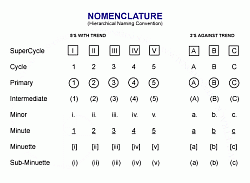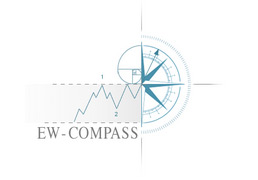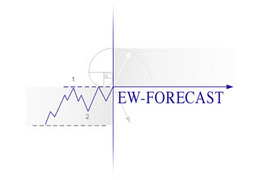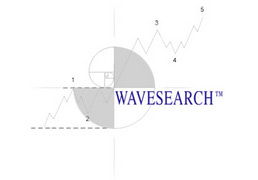|
Definitions & List of frequently used Elliott Wave & Technical Analysis Terms Terms
This glossary should serve to give a quick overview of the basic terms and definitions used in Elliott Wave. If you have any particular term or rule you did not find in this glossary, but would like to receive a short explanation please write to us services@wavetrack.com & we will update the list accordingly.
A
B C
D
E
F
G
H
I
J K L M N
O
P
Q R
S
T
U V
W
X Y Z
A
- Aggregate
-
Any Elliott Wave pattern formed by the co-joined collection of separate wave sequences
(opposite or antonym of 'component') e.g. a zig zag - itself composed by three separate
waves, A-B-C co-joined to form the pattern.
- Alternation
-
If wave two is a sharp correction, wave four will usually be a sideways correction, and vice versa.
- Alternate Count
-
An alternative assessment of a wave pattern that complies less to various rules and guidelines than the 'preferential' count as applied to The Wave Principle.
- Apex
-
Intersection of two converging boundary lines of a contracting triangle.
C
- Channelling
-
R.N.Elliott's description of drawing parallel boundary lines within an impulse pattern to determine support / resistance levels for ongoing waves.
-
Component
-
A wave that is a constituent part of a larger pattern, e.g. wave A within a zig zag – not to be confused with the 'subdivision' of a pattern because that would imply breaking down each of the three waves of a zig zag, A-B-C into minus -1 degree, i.e. 5-3-5.
- Convergence/Cluster
-
The term used to describe the effect where various fib-price-ratios are applied to differing wave degrees of pattern that results in a convergence of price at one specific area.
- Corrective wave
-
A three wave pattern, or combination of three wave patterns, which moves in the opposite direction of the prior impulse wave.
D
- Diagonal Impulse
-
a five wave pattern – there are two types (see below)
- Diagonal (Ending)
-
Ending pattern occurring only in 5th or C waves. Develops into a wedge shape that contains 'overlap'. All internal waves subdivide into threes although there are often exceptions. Can exist as two types – 'contracting' or 'expanding'
- Diagonal (Leading)
-
Continuation pattern occurring only in 1st or A waves that develops into a wedge shape that contains 'overlap'. Waves 1-3-5 normally subdivide into five wave sequences, although there are often exceptions. Can exist as two types – 'contracting' or 'expanding'
- Double Retracement
-
Follows a 5th wave extension where price retraces the preceding impulse in two stages – first by moving back within the range, normally to where the extension began, secondly by travelling in the direction of the termination of the 5th wave, but briefly into a new price extremity.
- Double Three
-
Combination of two simple sideways corrective patterns, separated by a wave labelled X.
- Double Zig Zag
-
Combination of two simple sharp corrective patterns, separated by a wave labelled X.
E
- Equality
-
In a five wave sequence, when wave three is the longest, wave five and wave one tend to be equal in price length and occasionally time.
- Expanded flat
-
Flat correction where waves B & C enters new price territory relative to the extremity established by wave A.
- Expanding Impulse
-
A five wave pattern characterised where one of the three impulse subdivisions 'extends' (is the extended wave or 'extension' – its amplitude measures larger than the other two).
- Extensions
-
Within a five wave pattern where one impulse wave (1, 3 or 5) measures far greater than the other two – additonally, but not exclusively, the extended wave subdivides into a further five wave sequence of -1 degree to the larger ongoing pattern creating a visual 9 wave seqeunce. Can also subdivide into -2 degrees to create a 13 wave sequence, and -3 degrees for a 17 wave sequence.
F
- Failure
-
see Truncated Fifth
- Leonardus filius Bonaccii. – Fibonacci Number Sequence
-
Fibonacci was an Italian mathematician from Pisa during the 12th Century. His most important work was the discovery of what is known as the Summation Series. This sequence of numbers begins as follows: 1,1,2,3,5,8,13,21,34,55,89,144 ad infinitum. Adding the last two numbers together yields the next in the sequence. Dividing any number into the preceding figure yields the decimal 0.618, into the second preceding, 0.382, the third, 0.236. Dividing into the following number yields 1.618 and 2.618.
These ratios can be found in many natural living things, such as spirals or shells, measurement of the beats of a human heart, the wing of a butterfly or the electrical oscillations of the brain. The scale and depth of Fibonacci's discovery cannot be overstated as he recognised a unified sequence of ratios governing growth and decay that underlies all natural phenomena.
The use of Fib-Price-Ratios applied to the Elliott Wave Principle break down into three main categories – 'extension', 'correlative' & 'retracement' ratios. Extension ratios are used for measuring price activity that projects beyond an existing high-low range – examples of use are for projecting target levels for wave 5 within an impulse pattern or wave C within a zig zag. Correlative ratios are used to compare the amplitude of two (or more) separate wave sequences within a larger progressive pattern – examples would be waves 1& 5 of an impulse pattern measuring to equality, 100%, and waves A & C of a zig zag. Retracement ratios are used to determine the partial contraction of a particular wave of its immediate predecessor. The most common Fib-Price Ratios are 14.58%, 23.6%, 38.2%, 61.8%, 76.4%, 100%, 114.5%, 123.6%, 138.2% & 161.8%. (see an example of how these ratios are applied).
- Fib-price-ratio
-
Fib-price-ratio measurements are based on Fibonacci ratios in order to determine the
price amplitude of each pattern. Every Elliott Wave pattern is attributed to a specific
fib-price-ratio which describes the variances or subtleties found to exist. Common ratios
are: e.g. 61.8%, 38.2%, 23.6%.
- Flat
-
Horizontal sideways correction, labelled A-B-C, parrallel highs & lows
- Fourth wave preceding degree
-
(see also Previous Fourth Wave) The fourth wave within the preceding impulse wave of the same degree. Corrective patterns typically terminate in this area.
G
- Golden Section
-
The Golden Section, also referred to as the 'Golden Cut'or 'Golden mean, is known since antiquity and was taught by Plato and Euclid as the 'Universal Law of Harmony'.
The 'Golden Section' is quite remarkable insomuch that it helps distinguish ratio (see Fibonacci Ratio) from proportion. A ratio constitutes a measure of difference – a comparison between two things. A proportion, however, is a relationship of equivalency between two sets of ratios, that is to say, one element is to a second element as the second is to the third. This is accomplished by dividing a line in such a way that - the smaller dimension is to the greater, as the greater is to the whole.
The 'Golden Section' is widely used in the application of Elliott Wave Theory in order to measure the price objectives of certain patterns. If is applied to the separation line, then three equations are derived – 0.382, 0.618 and 1.00 : 0.382 has the same relationship to 0.618 as 0.618 has to 1.00.
H
- Hierarchy
-
The order and classification of varying degrees of waves that helps to distinguish the relative position of one group from another.
I
- Impulse Wave
-
A five wave pattern – two types of impulse exist, 'expanding' & 'diaognal'
- Irregular Flat
-
see Expanded Flat
N
- Nomenclature
-
A system for the labelling and assigning of numbers and letters to wave patterns.

Click to see the WaveTrack International nomenclature
O
- One-two, one-two
-
The initial development in a five wave pattern, just prior to acceleration – this is nothing other than the 'extended' wave of an impulse that begins fractalistaion – subdivides into a series of smaller 1-2 sequences prior to an expanding 3rd wave. The extended wave can fractalise into additional subdivisions (1-2, 1-2 is -1 degree of trend [9 wave pattern sequence] – 1-2, 1-2, 1-2 is -2 degrees [13 wave pattern sequence] – 1-2, 1-2, 1-2, 1-2 is -3 degress [17 wave pattern sequence]) Can be found developing in 1st, 3rd & 5th waves
- Overlap
-
The incursion of wave four into the price territory of wave one. Not permitted in an 'expanding' five wave impulse pattern but is a prerequiste for the 'diaognal' five wave impulse pattern
P
- Pattern
-
A composition of singular waves that form into specific and recognisable patterns that R.N.Elliott discovered repeating in the financial markets. There are currently 13 archetypal patterns in the archive list of WaveSearch.
- Pattern-Centric
-
Views a complete Elliott Wave pattern as an aggregate/whole, e.g. zig zag or diagonal. It is the viewpoint from which to begin analysing and comparing differing patterns – see WaveSearch.
- Permutation
-
Specifically refers to the variable patterns a component wave can unfold into within a larger aggregate pattern – e.g. wave A of a zig zag must subdivide into a five wave sequence and so this can unfold into these varying possibilities – expanding impulse 1st extension, 3rd extension, 5th extension, diagonal leading-contracting, diagonal leading-expanding (totalling 5 permutations).
- Preferential Count
-
The primary assessment of wave pattern that complies mostly to the various rules and guidelines of The Wave Principle.
- Previous Fourth Wave
-
The fourth wave within the preceding impulse wave of the same degree. Corrective patterns typically terminate in this area.
- Proportion
-
The comparative relationship between ratios – in EW terms, this creates a harmonious convergence of price where varying degrees of pattern ratios come together to form a singular point – e.g. a zig zag is a counter-trend pattern comprising of waves A-B-C, subdividing 5-3-5 – extending wave A by a fib. 61.8% ratio projects the terminal conclusion for wave C converging towards an exact Fibonacci resistance level measured from the pattern of one higher degree, whilst measuring the five wave subdivisions of wave C of one lower degree also converge to the same price level.
R
- Ratio
-
The measurement relationship between two waves, e.g. fib. 100% equality between waves A & C within a zig zag pattern. Each wave exhibits varying ratio measurements to another depending on its relative location as the 'component' within its larger 'aggregate' counterpart – see WaveSearch for details.
- Running Flat
-
Sideways correction, labelled A-B-C but wave C ends inside trading range of wave B estblishing a 'truncation' (unlike the expanding flat, wave C cannot end beyond the price extreme established by wave A)
S
- Sharp Correction
-
Any corrective pattern which does not contain a new price extreme relative to the prior impulse wave; alternates with sideways correction.
- Sideways Correction
-
Any corrective pattern which contains a new price extreme relative to the prior impulse wave; alternates with sharp correction.
T
- Third of a Third
-
Powerful middle section within an 'extended' impulse wave (see also one-two-one-two)
- Thirteen Elliott Wave Patterns
-
Elliott documented thirteen basic but specific patterns that replicate in the markets – not exactly, but in form. By observing these graphically, composing them into their respective hierarchical order and applying them to certain governing rules, it is possible to forecast future activity in a two-dimensional way – pattern and price. They are as follows:
Trend / Impulse (5's):
- Impulse – expanding (1st, 3rd or 5th extension)
- Impulse – diagonal | leading or ending | contracting or expanding
Counter-trend / Corrective (3's):
- Zig Zag – single
- Zig Zag – double
- Zig Zag – triple
- Flat – horizontal
- Flat – expanding
- Flat - running
- Triangle – contracting
- Triangle – ascending
- Triangle – descending
- Triangle – expanding
- Combinations – double/triple threes
- Throw-over
-
Action attributed to wave five within a diagonal where it briefly penetrates the boundary line established by waves 1 and 3 before staging a reversal.
- Thrust
-
Sharp movement following completion of a triangle.
- Triangle
-
(contracting, ascending, descending and expanding) - Corrective pattern, labelled a-b-c-d-e. Occurs as 4th, B or X wave. Prices converge/diverge as pattern progresses.
- Triple Three
-
Combination of three simple sideways corrective patterns, separated by a wave labelled X.
- Triple Zig Zag
-
Combination of three simple sharp corrective patterns, separated by a wave labelled X.
- Truncated Fifth
-
Pattern in which the fifth wave fails to exceed the price extreme of the third wave – also applies to wave C within a running flat.
V
- Volume
-
A condition where volume normally diminishes in a fifth wave than compared to wave three. If higher in wave five, may indicate the propensity for 'extension'.
W
- Wave
-
The singular movement of price action – the term used to describe the components of an Elliott Wave pattern – “the passage of undulating motion…a single curve in the course of this motion". They form as the components of a larger 'aggregate' pattern, whilst themselves contain smaller component waves that means each wave is itself a pattern in its own right.
- Wave-Centric
-
Views all waves as separate sequences as parts of a greater aggregate/whole, or EW pattern. They annotate as follows: 1-2-3-4-5-A-B-C-D-E-W-X-Y-Z. It is the viewpoint from which to begin analysing and comparing differing waves – see WaveSearch.
- WaveSearch
-
WaveTrack's Elliott Wave tutorial tool listing all waves and patterns that comprise the Elliott Wave Principle. It has an archive of several thousand archived tutorial patterns and contains several hundred historical archived patterns. It specialised in the application of Ratio & Proportion relationships for each pattern. It is interactive software for the user to search, analyse and learn from the differing characteristics of Elliott Waves and Patterns.
- Wedge Shape Patterns
-
Wedge Shape Patterns also known as Diagonal Pattern (see Diagonal Patterns).
Z
- Zig Zag (Single)
-
Sharp correction, labelled A-B-C
- Zig Zag (double)
-
Sharp correction, labelled A-B-C-X-A-B-C
- Zig Zag (Triple)
-
Sharp correction, labelled A-B-C-X-A-B-C-X-A-B-C
A
B C
D
E
F
G
H
I
J K L M N
O
P
Q R
S
T
U V
W X Y Z
|
|





